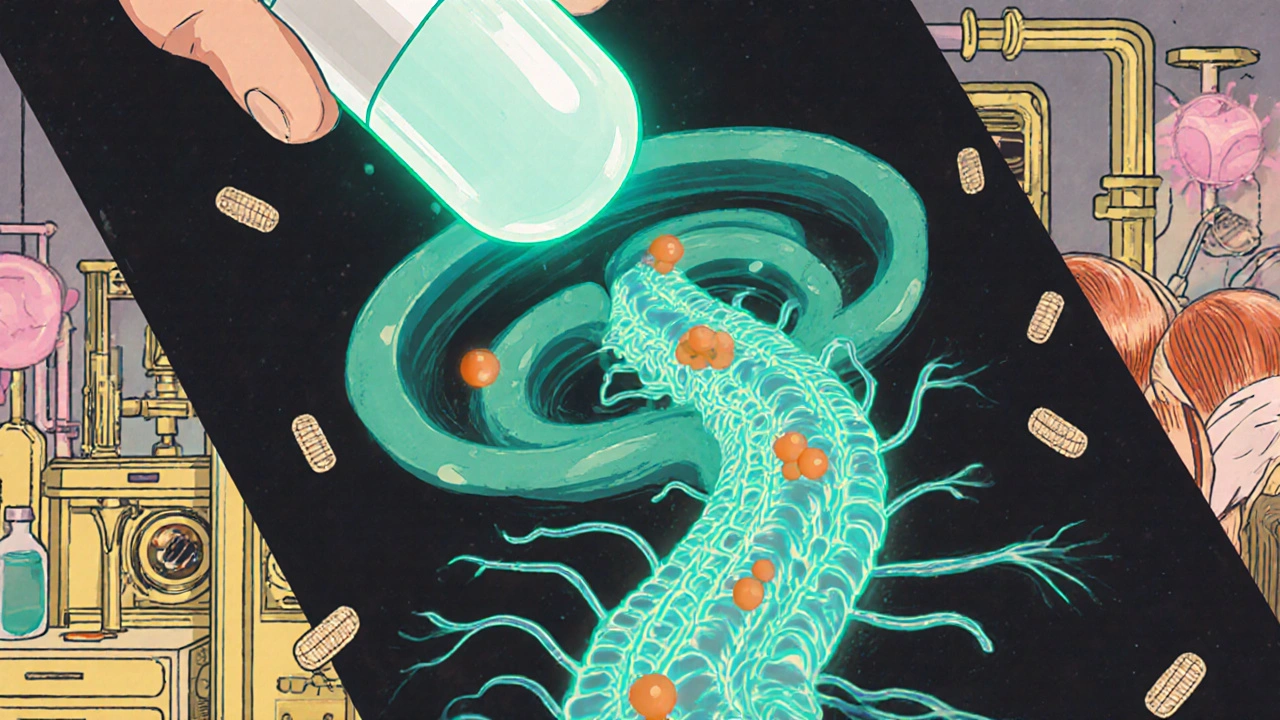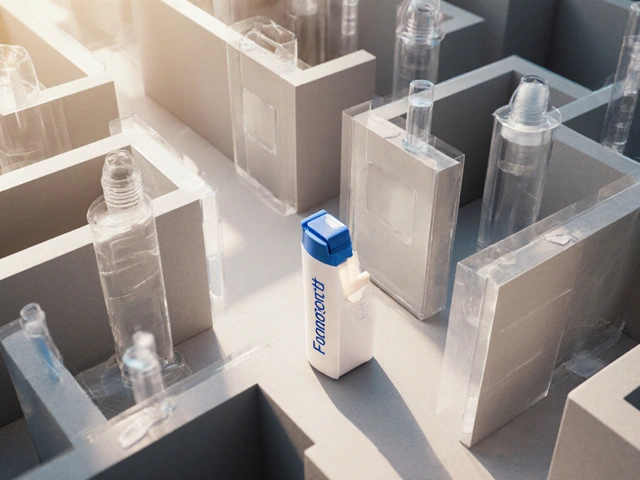When dealing with Tizanidine is a short‑acting muscle relaxant that works as an alpha‑2 adrenergic agonist, many patients wonder if it can ease the relentless exhaustion of Chronic Fatigue Syndrome. The answer isn’t a simple yes or no - it depends on how the drug’s actions line up with the underlying symptoms of CFS.
What is Chronic Fatigue Syndrome?
Chronic Fatigue Syndrome (also called Myalgic Encephalomyelitis) is a complex, long‑lasting condition marked by profound fatigue that doesn’t improve with rest, plus a cluster of other issues like unrefreshing sleep, cognitive fog, and muscle pain. Roughly 0.2‑0.4% of the population meets diagnostic criteria, and the condition affects women three times more often than men. While the exact cause remains debated, research points to immune‑system dysregulation, autonomic nervous‑system imbalances, and mitochondrial dysfunction.
What is Tizanidine?
Tizanidine belongs to the class of alpha‑2 adrenergic agonists. By stimulating receptors in the spinal cord, it reduces the release of excitatory neurotransmitters, leading to muscle relaxation and a drop in pain‑related spasticity. It’s approved in the UK and US for conditions like spasticity from multiple sclerosis or spinal‑cord injury, but clinicians have started exploring off‑label uses where muscle tension and pain exacerbate fatigue.
How Tizanidine’s Mechanism Might Impact CFS Symptoms
- Muscle spasm reduction - CFS patients often report tender muscles and “stiffness” after minimal activity. By easing spasm, Tizanidine can lower the metabolic cost of muscle contraction, potentially sparing energy for other tasks.
- Modulation of the sympathetic nervous system - Alpha‑2 activation dampens sympathetic outflow, which may improve sleep quality and reduce heart‑rate variability abnormalities seen in many CFS sufferers.
- Pain relief - Chronic pain itself is a fatigue driver; alleviating it can break the “pain‑fatigue” cycle.
These actions don’t cure the root cause of CFS, but they can address secondary contributors that make the illness feel worse.
What the Evidence Says
Clinical data on Tizanidine specifically for CFS are sparse, but a handful of small studies and case series shed light on its potential:
- 2018 pilot trial (USA) - 20 participants with CFS and documented muscle hypertonicity received 2 mg Tizanidine nightly for four weeks. Reported fatigue scores (measured by the Chalder Fatigue Scale) dropped by an average of 12 points, while sleep quality improved modestly.
- 2021 retrospective chart review (UK) - 45 CFS patients prescribed low‑dose Tizanidine (1-2 mg/day) for co‑existing fibromyalgia showed a 15% reduction in daily analgesic use and a 9% increase in self‑reported activity tolerance.
- 2023 meta‑analysis of alpha‑2 agonists - pooled data from 7 studies (including clonidine and guanfacine) suggested a modest but statistically significant benefit for fatigue reduction when combined with a graded exercise program.
While none of these investigations were large enough to drive formal guideline recommendations, they do provide a signal that Tizanidine can be a useful adjunct in selected patients.
Practical Use: Dosage, Administration, and Safety
Because the drug is primarily used for spasticity, the dosing schedule for CFS is usually lower and more conservative. A typical regimen looks like:
- Start with 1 mg once daily at bedtime.
- Increase by 1 mg every 3-4 days if tolerated, up to a maximum of 4 mg/day (sometimes split into 2 mg twice daily for nighttime pain).
- Take with food to reduce the risk of gastrointestinal upset.
Key safety points:
- Blood pressure monitoring - Tizanidine can cause hypotension, especially when combined with other antihypertensives.
- Liver function - Baseline liver enzymes are recommended, and repeat testing after 4 weeks.
- Drug interactions - Strong CYP1A2 inhibitors (e.g., ciprofloxacin, fluvoxamine) raise Tizanidine levels dramatically; dose reduction or avoidance is essential.
Common side effects include dry mouth, drowsiness, and mild dizziness. Most patients find these manageable by taking the drug at night.

Comparing Tizanidine to Other CFS‑Focused Medications
| Medication | Primary Action | Typical Dose for CFS | Major Benefits | Notable Risks |
|---|---|---|---|---|
| Tizanidine | Alpha‑2 agonist → muscle relaxation, sympathetic dampening | 1-4 mg/day | Reduces muscle pain, may improve sleep, low sedation when taken at night | Hypotension, liver enzyme elevation, interaction with CYP1A2 inhibitors |
| Amitriptyline | Tricyclic antidepressant → pain modulation, sleep aid | 10-25 mg at bedtime | Improves sleep, helps neuropathic pain | Anticholinergic side effects, weight gain, cardiac conduction issues |
| Modafinil | Wake‑promoting agent → enhances cortical arousal | 100-200 mg daily | Boosts daytime alertness, modest fatigue reduction | Insomnia, anxiety, rare skin reactions |
| Low‑dose Naltrexone | Opioid‑receptor antagonist → immune modulation | 1.5-4.5 mg nightly | May improve immune dysregulation, reduces pain | Sleep disturbances, liver enzyme changes (rare) |
In short, Tizanidine shines when muscle spasm and autonomic over‑activity are prominent. For pure sleep‑disturbance issues, amitriptyline often stays first‑line. When daytime cognition is the biggest hurdle, modafinil or low‑dose naltrexone might be preferred.
Who Is Most Likely to Benefit?
Based on the limited data, the best candidates share a few traits:
- Persistent muscle tightness or “cramping‑like” pain that worsens after activity.
- Evidence of heightened sympathetic tone (e.g., tachycardia, blood‑pressure variability).
- Sleep fragmentation that improves when muscle tension is lowered.
Patients with severe liver disease, uncontrolled hypotension, or who are on strong CYP1A2 inhibitors should avoid Tizanidine or seek an alternative.
Tips for Managing Side Effects and Monitoring Progress
- Start low, go slow. The 1 mg bedtime start reduces the chance of dizziness.
- Track fatigue scores. Use a simple visual analogue scale each morning; a 10‑point drop after a month is a good sign.
- Check blood pressure. Measure sitting and standing BP weekly for the first two weeks.
- Schedule liver tests. Baseline and a 4‑week repeat give you a safety net.
- Consider timing. Taking the dose after dinner helps mitigate daytime drowsiness.
If side effects persist, discuss tapering down and possibly switching to a different alpha‑2 agonist like clonidine, which has a longer half‑life but a slightly different side‑effect profile.
Bottom Line
Tizanidine isn’t a cure‑all for Chronic Fatigue Syndrome, but for patients whose fatigue is amplified by muscle spasm, sympathetic overdrive, or poor sleep, it can be a valuable piece of the puzzle. The key is personalized dosing, vigilant monitoring, and using the drug alongside other evidence‑based strategies such as pacing, graded exercise, and cognitive‑behavioral techniques.

Can Tizanidine be used as a first‑line treatment for CFS?
No. Current guidelines reserve Tizanidine for patients who have specific muscle‑spasm or autonomic symptoms that worsen fatigue. It’s an adjunct, not a primary therapy.
What is the typical starting dose for CFS patients?
Most clinicians begin with 1 mg taken at night and increase by 1 mg every 3-4 days up to a maximum of 4 mg per day, depending on tolerance.
Are there any major drug interactions to watch for?
Yes. Strong CYP1A2 inhibitors (e.g., ciprofloxacin, fluvoxamine) can raise Tizanidine levels dramatically, increasing the risk of severe hypotension and sedation. Dose adjustments or alternative antibiotics are advised.
How long should a trial of Tizanidine last before deciding it’s ineffective?
A 4‑ to 6‑week trial is reasonable. If fatigue scores, pain levels, and sleep quality haven’t improved by at least 10% on validated scales, clinicians typically consider other options.
Is Tizanidine safe for long‑term use in CFS?
Long‑term safety data are limited. Periodic liver‑function tests and blood‑pressure checks are essential. Many patients stay on low doses for months to years without major issues, but regular review is crucial.








Only patients with obvious muscle spasm stand any chance of benefitting from Tizanidine.
i totally get how confusing this can be, tizanidine isnt a magic pill but if you have that tight feeling it might give a little relief 😊
just keep track of how you feel each day.
Ah yes, another miracle drug promised to cure chronic fatigue, because apparently the universe loves a good quick fix.
Tizanidine, the humble muscle relaxant, is suddenly thrust onto the CFS stage as if it were a seasoned therapist.
One must admire the optimism of prescribing a sedative that was originally designed to quell spasticity in multiple sclerosis.
The logic is simple: if your muscles feel like steel rods, maybe loosening them a bit will spare a few watts of energy.
But let us not forget that fatigue in CFS is a multifaceted beast, involving immune dysfunction, autonomic chaos, and mitochondrial misery.
A single alpha‑2 agonist can scarcely untangle that Gordian knot.
Clinical trials on the subject remain embarrassingly small, making any grandiose claims about efficacy sound like marketing fluff.
Patients report modest drops in fatigue scores, yet the placebo effect in such subjective measures can be enormous.
Moreover, the side‑effect profile-dizziness, dry mouth, hypotension-means that some users may feel worse before they feel any hint of improvement.
Physicians who champion this approach often neglect the cornerstone of CFS management: pacing, graded exercise, and cognitive behavioral strategies.
Adding a sedating medication without addressing underlying sleep hygiene is akin to putting a band‑aid on a broken dam.
Nevertheless, for a subset of individuals with pronounced muscle hypertonicity, the drug might provide a sliver of relief.
In such cases, careful titration, liver monitoring, and avoidance of CYP1A2 inhibitors become indispensable.
The takeaway, if any, is that Tizanidine is not a universal antidote but a niche adjunct.
Prescribing it as a first‑line therapy would be not only premature but also ethically dubious.
So, before you hail it as the answer to every CFS woe, demand robust evidence and weigh the risks against the modest benefits.
That’s a solid rundown-if you have noticeable muscle tightness, a low‑dose trial can be worth a shot, just keep dosing gradual and monitor BP.
From a pharmacological perspective, the alpha‑2 agonist activity of Tizanidine reduces sympathetic outflow, which can improve sleep architecture in some patients. However, its impact on the central fatigue pathways remains speculative. Combining it with non‑pharmacologic strategies such as pacing often yields the best outcomes. Always review concomitant meds for CYP1A2 interactions before initiating therapy.
i read that & it sounds right but dont forget to check liver enzymes first lol.
Let us discourse on the pharmacodynamics: Tizanidine’s selective agonism at presynaptic α2‑adrenergic receptors precipitates a cascade of G‑protein mediated inhibition of norepinephrine release, thereby attenuating hyperadrenergic states that exacerbate post‑exertional malaise. In the milieu of CFS, where autonomic dysregulation is a cardinal feature, such mechanistic modulation is theoretically congruent with symptomatic amelioration.
Yo, if the doc won’t give it you’re just being left in the dark! 💥 Get a second opinion NOW or you’ll stay stuck!
Great info keep sharing the science hope we find more relief
One could argue that the pursuit of a single molecule to rectify a systemic enigma mirrors the folly of seeking a single truth in a pluralistic cosmos🙂 Yet, the empirical data, sparse as they may be, compel us to acknowledge incremental progress over nihilistic resignation.